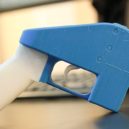3D PRINTING IN CRIME INVESTIGATION

What would Johannes Gutenberg, the man who invented the first modern printing press in 1454, have said if someone told him that one day we would be printing human beings? He would have probably cocked a snook at the idea. Recently, in 1997, “ The Fifth Element” an iconic sci-fi film made by the French director Luc Besson, featured a massive 3D bio-fabricator which 3D prints the entire body of Leeloo (Milla Jovovich). It now turns out, that most of the prescient peeks of future provided by sci-fi invariably have been coming true. 3D printers of today don’t only have the capability to print human tissues and organs, but also guns and a myriad other things.A 3D printer today is like a magical machine which has the ability to create material objects at the push of a button using different kinds of materials such as plastic, metal, wood, concrete, ceramics, etc. Just as we can send an image to a 2D ink-jet printer, we can download or create a design on our laptops and send it to a 3D printer, which in turn using a smorgasbord of techniques, can build objects in three dimensions, layer by layer, with unprecedented exactitude. These digital manufacturing methods are making it easier and more economical to fabricate a whole variety of products from robots to aviation parts to fully functioning automobiles, equipment etc.
This technology is becoming so widespread today that a casual ‘YouTube’ search would generate hundreds of videos of 3D printed houses, equipment’s, cars, etc. NASA has procured a 3D printer for the International Space Station from a start-up called “Made in Space” to ensure missing parts are replaced on board without endangering the lives of astronauts. Bespoke Innovations has created a next-generation customized prosthetics with a perfectly designed fit. Bio-fabricating printers are printing human tissues and organs, such as kidneys, hearts, etc. as well as food and meat to eat.
When one can print things one needs at home, why go shopping? Or import cheap crap all the way from China? The cost of home 3D printers has also witnessed a precipitous fall, Cube3 made by ‘3D Systems ‘ is now sold at Staples for $999. Amazon has created its own 3D printing store and Web sites such as ‘Thingiverse’ which have become the go-to locations for users to freely share and customize their digital design files. ‘MakerBot’ is offering kits to build your own 3D printer, Autodesk’s free 123D software and apps can turn any 3D digital model into a real-world object, These developments are shifting manufacturing away from mass production toward mass customization, where people can print whatever they want.
Although there is an intense focus at the moment of using this technology for consumer goods, 3D printing is proving to be a valuable tool in the criminal investigation. 3D printing can be used by police to recreate detailed models of crime scenes, car crashes, footprints and fingerprints, as well as develop prototypes of frameworks for anti-terrorism and anti-hijacking interventions. If CT scans or MRI scans, of the victims, can be taken such data can be used to 3D print models that allow investigators to examine injuries as well as bone and bullet fragments of wounds on the outside as well as inside. It also allows investigators to analyze and measure the path of a bullet or a knife as well as its trajectory in relation to the entry point and surrounding tissue. Such models could be 3D printed and presented clearly in the courtroom, which could be easily understood even by a layman. Like many technologies, 3D printing have a dark side, and criminals are using 3D printers to commit crimes which I shall explore separately in my next article.
Most noteworthy detection using a combination of 3D scanning and 3D printing was the notorious “suitcase killing” case of Birmingham, UK in May 2015. In which Lorenzo Simon murdered his tenant, Michael Spalding, by severing the body with a saw and partially burning it, before submerging the suitcase filled with the victim’s body parts in the Birmingham canal. Employing 3D printing, the West Midlands Police, with the help of the University of Warwick Manufacturing Group, was able to establish that a piece of charred broken bone found in the suspect’s back garden was a precise fit for a piece of broken bone found in the suitcase.
In another crime scene investigation in the USA, which necessitated accessing the data on the dead victims mobile phone, the fingerprint of the dead person was recreated using a 3D printed cast since the victim’s body was too decayed to extract the fingerprints with the existing methods. Unlocking the victim’s device, with the 3D printed victim’s finger, helped in procuring evidence from the device leading to the arrest of the killer.
3D Printing technology also helped identify the body of a woman found in the woods near Dayton, Ohio. The Greene County Ohio Sheriff’s Office teamed with Ohio State University in late 2016 after all attempts to recognize the victim from the greatly putrefied remains didn’t succeed. After CT scanning and 3D printing, a prototype of the victim’s skull was developed using clay for moulding and sculpting the face. Facial aspects of the model were then circulated in the public, which expeditiously resulted in the victim being positively identified. Subsequently, the police were also able to identify and arrest the suspects a short time later.
A murder case which was unsolved for nearly two decades in Japan could be detected by reconstructing evidence using a 3D printed scan of the room, similarly forensic anthropologist students of the University of South Florida after teaming with imaging experts are using 3D printing to try and help identify the victims in nine Florida cold cases, some of which are decades old. After 3D printing replicas of the victims’ skulls from 3D scans, the students have rebuilt the faces with clay, then sculpted the lips and inserted fake eyeballs.
New York State Police sometime back partnered with the State University of New York (SUNY) New Paltz Hudson Valley Advanced Manufacturing Center to crack a 47-year old Jane Doe murder case. The SUNY team 3D printed a carbon copy of the victim’s skull and handed it over to a forensic artist who recreated the victim’s face. In another case, the death of six-year-old Ellie Butler in Sutton, England in 2013, was proved by forensic pathologists during the homicide prosecution of her parents by presenting detailed replicas of Ellie’s severely damaged skull, which were 3D printed from CT scans of her remains.
The Hong Kong Police Briefing Support Unit is making use of 3D printers owned by it to create crime scene models, which can help recreate the crime and present cases in court. The unit is also making use of 3D printed prototypes of buildings in counterterrorism planning. In 2013, a 3D printed model of a crime scene helped Japanese police gather thousands of possible case-related clues from local citizens.
Abu Dhabi Police is planning to deploy 3D printing for the handling of evidence with 3D printed dioramas which would help assess a crime scene. West Yorkshire Police, UK, and Cascade County Police in Montana, USA, have also taken to 3D scanning in crime investigation like several police agencies in Europe and USA. They have also installed their own 3D printers. A Florida company, ‘3D Printed Evidence’, is helping police convert data from MRIs, CT scans and 3D scanners into physical models. Police units which lack the budget or the personnel to 3D print replicas can consider outsourcing the work to local or university 3D printing services. This is a disruptive technology, which can go a long way in solving crimes and convicting perpetrators. Police in India too, I am sure, would be compelled very soon to install 3D printers and scanners for Crime investigative work as they cannot afford to straggle behind by overlooking this amazing technology. Finally, our consciousness also is like a 3D printer, it will generate whatever you ask of it. The lives we are leading today, are exact 3D replicas of all that we have thought, believed and done. If we discover we are unhappy, we can hack our consciousness through silent contemplation and positive thought to bring magic like a 3D printer into our lives , by manifesting our dreams and desires.
Source from: epaper/deccanchronicle/chennai/dt:22.10.2018
 Dr.K. Jayanth Murali is an IPS Officer belonging to 1991 batch. He is borne on Tamil Nadu cadre. He lives with his family in Chennai, India. He is currently serving the Government of Tamil Nadu as Additional Director General of Police, DVAC.
Dr.K. Jayanth Murali is an IPS Officer belonging to 1991 batch. He is borne on Tamil Nadu cadre. He lives with his family in Chennai, India. He is currently serving the Government of Tamil Nadu as Additional Director General of Police, DVAC.


